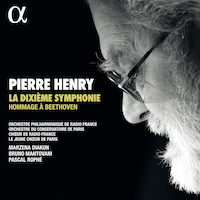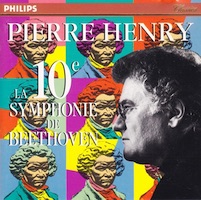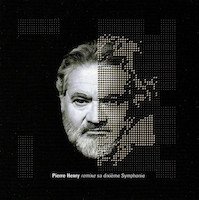Mostly Symphonies 39. / EA Bucket 32: Pierre Henry +/- Beethoven
|
[I’ll eventually get around to another Beethoven’s Tenth that’s been in the news. But first…] Grant Chu Covell [December 2021.]
Pierre HENRY: La Dixième Symphonie de Beethoven (1974-79; vers. 1986/88). Philips 420 636-2 (1 CD) (o/p). Pierre HENRY: La 10ème Remix (1974-79; vers. 1998). Philips 462 821-2 (1 CD) (o/p). Pierre HENRY: La Dixième Symphonie: Hommage à Beethoven (1974-79; eight-movement vers. arr. for three orchestras by Maxime BARTHÉLEMY and Misael GAUCHAT, 2019). Benoît Rameau (ten), Orchestre Philharmonique de Radio France, Orchestre du Conservatoire de Paris, Chœur de Radio France, Le Jeune Chœur de Paris, Marzena Diakun, Bruno Mantovani, Pascal Rophé (conds.). Alpha 630 (1 CD) (www.outhere-music.com). It’s hard to know where to begin. There’s more going on here than just a few hours of musique concrète and three orchestras navigating a collage. Electroacoustic composer Pierre Henry minced and transformed bits of Beethoven’s nine symphonies to create his own “Tenth.” In fact, Henry created multiple versions of Beethoven’s Tenth. There are three electroacoustic versions: the 1979 original which may never have been issued commercially, the 1988 pressing of the 1986 version (which is scarce), and the 1998 remix (which is readily available). In 2020, a recording of eight movements of a posthumously assembled orchestral edition was released. Because of Beethoven’s place in our culture, Henry’s medley easily provokes, and listeners (and performers) bring their own contexts into the mix. No two listeners will hear what he has done in the same way. Certainly, the unsuspecting concertgoer would be perplexed. Why do this to Beethoven? Likewise, the electroacoustic aficionado may not comprehend Henry’s intentions when presented with either the 1986/88 or 1998 recordings. I wonder about Henry’s intentions. Notes in the score and accompanying the Remix and orchestral recordings reveal Henry’s techniques, but not his philosophy. Comparing the electronic to the three-orchestra arrangement opens a detour into the nature of recording and of aural manipulation, all of which can disturb the magic of electroacoustic music. Revisiting the Remix especially, I suspect other forces at play, other attitudes not usually expressed in electroacoustic music. And after shuffling through these three releases, I am surprised at which one I liked best. “Beethoven taught me more about composing than Messiaen did.” According to the composer, Henry’s approach to La Dixième Symphonie began in 1974. After a thorough analysis, Henry catalogued distinctive features. He extracted what pleased him, physically cutting up printed scores, extracting chords, melodies, themes, cadences, backgrounds, etc., and then pasting them into new configurations. The same process followed with tape recordings, based upon Henry’s physical score. Because Henry left behind posters with strips of paper it became possible to devise a performing score for orchestra (and the first tape version became a realization of the orchestra edition). Who is Henry’s intended audience? The listener who knows enough Beethoven to perceive what Henry is doing? What about the listener who doesn’t know Beethoven? Would we be having this discussion if the original sources had been Schubert or Cherubini? Henry assures us it is ok for him to use Beethoven in this way because he has spent years studying Bonn’s favorite son and has long admired the composer. Ironically Henry mentions spending time with Liszt’s piano arrangements of the symphonies which are themselves composed transformations, Beethoven seen through the eyes of another. Henry’s title references Beethoven’s cultural hold, as well as the Ninth Symphony as pinnacle achievement. Beethoven did leave sketches for a Tenth symphony, unfinished at his death. Henry is not interested in that. This Tenth is derived from the prior nine which Henry intends to summarize or culminate. “Beethoven’s Tenth” explicitly ventures where few other composers have dared to tread, to one-up Beethoven, to surpass the legend. Henry succeeds when Beethoven is familiar. Henry also infuriates if Beethoven is familiar. What does a listener hear who does not recognize the sources? Because the Remix adds additional material, can it suggest what La Dixième sounds like to someone unfamiliar with Beethoven? Because Henry’s sources are immediately identifiable and unprocessed, we can witness how musique concrète comes together. Henry utilizes the same process in other pieces, but in La Dixième the functions of editing, looping and repeating are laid bare. As the composer remarks, he spent much time and effort selecting his raw materials. This is the composer’s job, and the best practitioners are experts at finding the right sources, editing them, and organizing them. The initial tape version was completed in 1979 for a concert in Bonn (October 25, 1979), with Isabelle Warnier (Warnier was Henry’s partner as well as assistant). It does not appear that the 1979 instance was published. It is not clear how the 1986/88 release relates to the 1979 effort. The 1986/88 production can be found through various resellers, though usually at exorbitant prices. The 1986/88 version has nine movements and lasts 53:07:
Technically, the 1986/88 release focusses mostly on collage. There is infrequent time-stretching (an excerpt appearing at a different speed and pitch). (Note that the 2017 three-orchestra version seems to be at a different pitch than the 1986/88 recording.) There are few backwards passages (in the Scherzo), and as the nine movements progress, we hear gradual distortion (for example, the first time we hear the orchestral introduction to the Ode to Joy). The presumably intentionally degraded signal quality suggests poorly spooling tapes, or tapes intentionally not completely touching the playback head. The effect (in Allegro con brio) can be nauseating. Once or twice, we hear the slurp of the tape changing speed at the start of a clip or similar artifacts of a sloppy splice, a surprising intentional choice considering Henry and Warnier were experts at their craft. La Dixième is a personal tour through preferred bits and pieces, organized and juxtaposed. The originals are most always recognizable. Presented differently, we may understand what Henry liked, how he related different motives to each other, and perhaps appreciate his perspective on Beethoven. The sources are never transformed into something ghoulish or nightmarish (an easy concrète trope) and there is not much humor (is Beethoven ever funny?). We do not learn more about Beethoven or Henry. The 1998 Remix has ten movements and lasts 56:40:
The Remix release is accessible to purchase and to stream online. It appears to leverage material heard in the 1986/88 release but is a completely different ten-movement work. I imagine it as Henry attempting a fresh start with the material, intentionally discarding original intentions as if he did not “hear” the original source. Perhaps Henry was in a sarcastic mood poking fun at himself and the entire idea of concocting Beethoven’s Tenth from the preceding nine. It does not seem as polished as other Henry works. Premiered July 4, 1998, at the Montreux Jazz Festival, Henry had help from Bernadette Mangin and Isabelle Warnier. At the opening of the Remix we hear a tape machine coming to life as tapes themselves are sped and slowed. Then abrasive techno pulsing obscures Beethoven, and a looped crooner suggests Elvis. I have not listened obsessively enough to determine whether Henry’s Beethoven pieces are taken exclusively from his 1986/88 version, or if Henry added additional Beethoven material. It sounds like the Remix Presto subsumes the 1986/88 Presto. There’s a part of me which doesn’t want to know and doesn’t want to undertake the analysis and close listening. The additions in Remix are predominantly ornamental and undeveloped: looped drumbeats, repeated rhythmic backgrounds and overlaid sound effects suggesting spaceships and cuckoo clocks. It’s like a student using multiple-colored fluorescent highlighters on a screenplay. Remix’ Enfants submerges Beethoven beneath drumkit, blippy techno pulses and the sound of children playing. Guerre adds gunshots, Aube’s looped beginning of the Ninth incorporates animals and birds. In the Finale, the drums gradually overwhelm. The entire Remix concludes with running water. When the tap shudders closed, the piece stops. Overall, it’s as if Henry was trying to cover his tracks with the cheapest possible paint. “But watch out! I don’t like everything in the Symphonies. I’ve only taken what I liked best.” When we listen to electroacoustic works which include manipulated excerpts of musical recordings, there are two powerful assumptions: 1) The original performers had no idea that their recording would be manipulated later, and 2) The listener knows that even if a portion of the recording is recognizable, that what comes out of the speaker has been manipulated. In electroacoustic works, the composer’s intent can completely subvert the recorded source’s intent. One of the strengths of the electroacoustic medium, is that the composer can repurpose the source recording’s original meaning and emotions. The eight-movement orchestral version (three orchestras, chorus and tenor soloist) runs 74:08, and was premiered on November 23, 2019, in Paris:
Henry had envisioned a twelve-movement version (three orchestras, chorus and tenor soloist) which runs nearly two hours:
(The eight-movement version is movements 3, 4, 5, 6, 7, 10, 11 and 12.) The Editor’s Notes for the performance score indicate that in addition to Henry’s physical artifacts (collaged measures from Liszt’s piano reduction) the 1979 tape version was the blueprint for the orchestral edition. A video of the three-orchestra version (taped at the November 23, 2019 premiere and formerly visible here) is an unexpected gift which illustrates how these two assumptions are thwarted. I am in the audience, and I can see the orchestra repeating the same material (physically initiating a loop). I can see that the players are slightly uncomfortable, and that playing the material while another orchestra is going through the same process (physically initiating a superimposition) is taking a certain amount of concentration different than if the musicians were playing the same material in its original context. The orchestra which is intentionally playing “wrong” is aware it is engaged in the process of distortion. This effects the performance, and in turn, our experience of what we hear. Perhaps we sympathize with the players, and we become distracted as we observe how the mechanics don’t align with what we hear. We know we are not really hearing Beethoven. The players know they aren’t following Beethoven’s intentions. The perfect orchestra can be manipulated in the electronic studio. The composer can make the perfect orchestra sound silly or willfully undermine the perfect orchestra’s intentions. We no longer think of the orchestra as human bodies performing, but we hear sounds that trigger emotions most likely not present when the original recording was taped. Our reactions to electroacoustic music are derived from our own experiences, as we hear sounds in different contexts, or new sounds that we try to align with other things we have heard. The listener’s interpretation of electroacoustic music is generally subjective and requires experience with sound in the ordered, natural world. It must have perplexed to have heard the three orchestras live. It was an enormous amount of labor and coordination, but for what end? There would have been audience members delighted to identify many excerpts, just as there would have been concertgoers who had no idea what was happening. But audiences are forever adaptable. Beethoven’s Sixth contains the simulation of a storm (and, depending upon your imagination, a rainbow’s creation). Can we imagine how shocking or how strange it was when Beethoven’s audience heard the Pastoral for the first time? Did Beethoven’s audience hear an imitation of the weather? Today we so completely associate “storms in music” with Beethoven’s Allegro: “Gewitter, Sturm” that it is impossible to think of thunder without thinking of Beethoven. Given the slow but steady trickle of Henry reissues and rebundlings, it surprises that the 1986/88 disc has not resurfaced. My suspicion is that Henry’s originals are problematic, that someone somewhere doesn’t want to deal with the licenses and royalties of the original recordings. The notes to the 2019 orchestral score state that Henry had used tapes made by Philips that were never issued. Maybe a sleuth can figure out what they were. (Note that a different recent electroacoustic exploration of Beethoven’s symphonies, Wolfgang Mitterer’s Nine in One, was commissioned by col legno who could provide the Haydn Orchestra of Bolzano and Trento’s recordings.) Listening intently, I come out of this with completely different impressions. In the 1986/88 version, I had expected Henry to have consistently worked with smaller Beethoven bits. For example, in Fantasie I there is a fine passage which jumbles the Fifth’s opening and the Ninth’s Scherzo. I imagine this was a lot of effort back in analogue times. Other Henry compositions seem so much more sophisticated. Having heard the 1986/88 release, I find the Remix more successful. Regardless, I find the distortion in both the 1986/88 and Remix versions distracting. The orchestral rendition became less bothersome the more I listened to it. I stopped worrying about its relative effort, its absurdity and in-concert impracticality. After several spins, it charms to hear the three orchestras play Henry’s Scherzo.
[Previous Article:
Used Bin Troll Tweets DDD.]
[Next Article:
Concerto Concentrations 6.]
|


